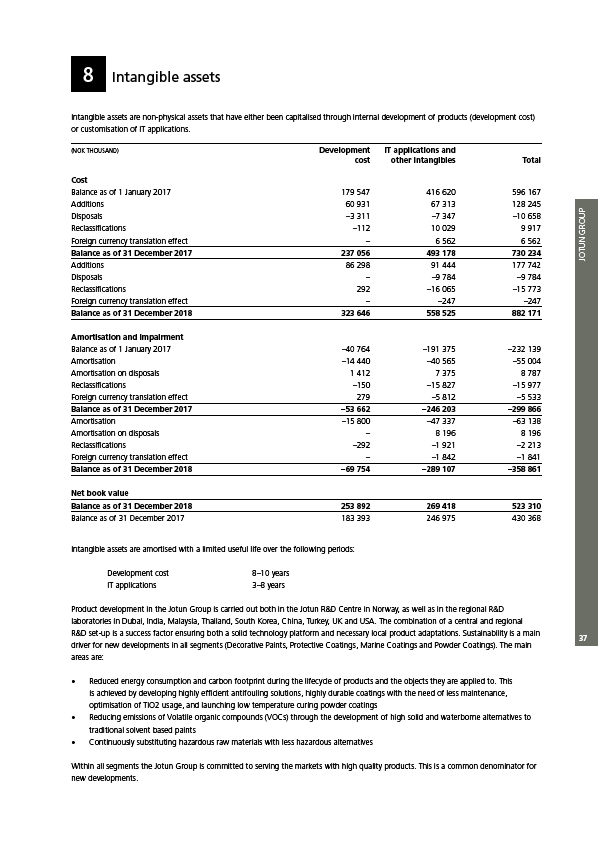
JOTUN GROUP
37
8 Intangible assets
Intangible assets are non-physical assets that have either been capitalised through internal development of products (development cost)
or customisation of IT applications.
(NOK THOUSAND) Development IT applications and
cost other intangibles Total
Cost
Balance as of 1 January 2017 179 547 416 620 596 167
Additions 60 931 67 313 128 245
Disposals –3 311 –7 347 –10 658
Reclassifications –112 10 029 9 917
Foreign currency translation effect – 6 562 6 562
Balance as of 31 December 2017 237 056 493 178 730 234
Additions 86 298 91 444 177 742
Disposals – –9 784 –9 784
Reclassifications 292 –16 065 –15 773
Foreign currency translation effect – –247 –247
Balance as of 31 December 2018 323 646 558 525 882 171
Amortisation and impairment
Balance as of 1 January 2017 –40 764 –191 375 –232 139
Amortisation –14 440 –40 565 –55 004
Amortisation on disposals 1 412 7 375 8 787
Reclassifications –150 –15 827 –15 977
Foreign currency translation effect 279 –5 812 –5 533
Balance as of 31 December 2017 –53 662 –246 203 –299 866
Amortisation –15 800 –47 337 –63 138
Amortisation on disposals – 8 196 8 196
Reclassifications –292 –1 921 –2 213
Foreign currency translation effect – –1 842 –1 841
Balance as of 31 December 2018 –69 754 –289 107 –358 861
Net book value
Balance as of 31 December 2018 253 892 269 418 523 310
Balance as of 31 December 2017 183 393 246 975 430 368
Intangible assets are amortised with a limited useful life over the following periods:
Development cost 8–10 years
IT applications 3–8 years
Product development in the Jotun Group is carried out both in the Jotun R&D Centre in Norway, as well as in the regional R&D
laboratories in Dubai, India, Malaysia, Thailand, South Korea, China, Turkey, UK and USA. The combination of a central and regional
R&D set-up is a success factor ensuring both a solid technology platform and necessary local product adaptations. Sustainability is a main
driver for new developments in all segments (Decorative Paints, Protective Coatings, Marine Coatings and Powder Coatings). The main
areas are:
• Reduced energy consumption and carbon footprint during the lifecycle of products and the objects they are applied to. This
is achieved by developing highly efficient antifouling solutions, highly durable coatings with the need of less maintenance,
optimisation of TiO2 usage, and launching low temperature curing powder coatings
• Reducing emissions of Volatile organic compounds (VOCs) through the development of high solid and waterborne alternatives to
traditional solvent based paints
• Continuously substituting hazardous raw materials with less hazardous alternatives
Within all segments the Jotun Group is committed to serving the markets with high quality products. This is a common denominator for
new developments.